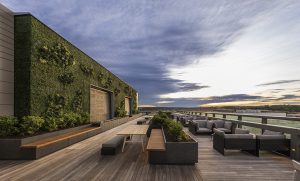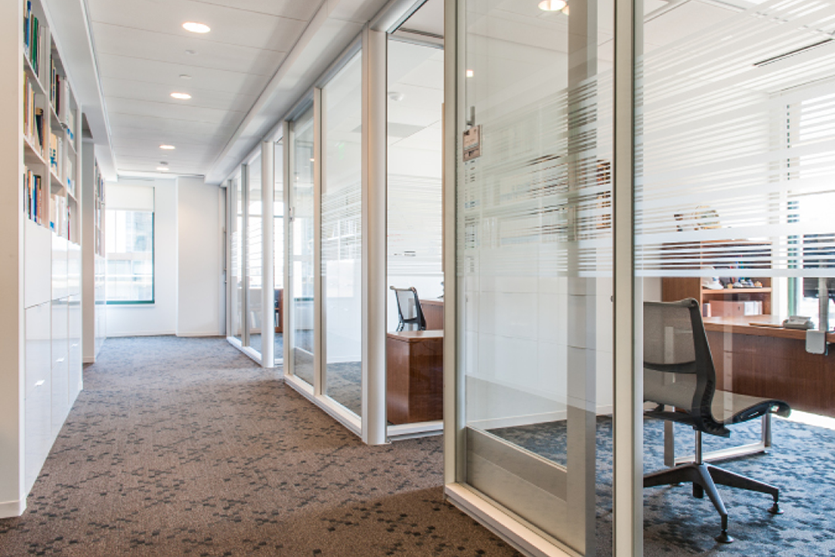by Victoria Lanteigne, Director of Strategic Partnerships at FOX Architects; Member, WELL Task Force on COVID-19
No doubt, the COVID-19 pandemic has rocked the design and architecture industry to its core. We have been seeking solutions for new concerns about the spread of disease in the workplace, and we are even asking hard questions such as, “What is the value of an office?” While our industry aims to thoughtfully consider how this global health pandemic will change the nature, function, and design goals of our workplaces, we are presented with a unique opportunity to apply a new lens to challenges that have existed in workplaces for decades.
Our current pandemic is not only an opportunity to design workspaces that promote health and safety — it is an opportunity to create environments that support well-being for even more people, including people with disabilities, who comprise at least 19.3% of the workforce. Disability, as defined by the Americans with Disabilities Act (ADA), includes a broad range of physical and mental impairments that limit one or more major life activity, including physical, sensory, cognitive, learning, and psychological disabilities. This means that a comprehensive approach to designing environments that promote health, safety, and wellness needs to take into account the full, diverse range of user experiences, some of which are related to disability. Indeed, even as we’ve designed environments for healthy bodies and minds, there is room to more comprehensively address the full spectrum of user experiences beyond a narrow set of ADA-compliant guidelines for improving physical access to spaces.
As we consider the next iteration of the workplace, we can address today’s most pressing needs while simultaneously bringing in from the margins those who have been left out from full inclusion in work environments. Universal design is an approach that, at this critical juncture, provides a way forward and enables us to do so for as many people as possible.
What is Universal Design?
Universal design can be defined as, “A process that enables and empowers a diverse population by improving human performance, health and wellness, and social participation.”It is an approach to design that aims to create the best experience for as many people as possible. While universal design is rooted in creating inclusive environments for people with disabilities, it differs distinctly from accessible design regulated by federal laws and building codes which typically focus on access for individuals with physical disabilities. Rather, universal design aims to create spaces that not only accommodate the wide spectrum of disability — including sensory, learning, physical, neurodiversity, mental and emotional disabilities, among others — but also strives to create flexible, usable, and intuitive spaces for people of all ages, abilities, backgrounds, sizes, etc. Newer schools of thought position universal design strategies to account for health and wellness, gender, and cultural identity within the built environment. Universal design strategies, in sum, are simple, smart, and intuitive design concepts that create better environments for all building occupants.
Universal Design, Health, and Wellness
Universal design strategies complement leading design strategies for health and wellness, helping achieve common goals, yet serving more individuals. Since 2017, I have been serving as an advisor on the WELL Community Concept Advisory Committee to provide guidance on the connection between universal design and healthy buildings. Together with the International WELL Building Institute, we have worked to incorporate universal design into WELL v2: Feature 13: Accessible and Universal Design, which highlights universal design as a strategy to promote flexible, usable, and intuitive spaces that in turn can contribute to reducing anxiety, promoting safety, and leading to overall healthier, more equitable, and more usable environments for all building occupants. In addition, aspects of universally designed environments can encourage social participation for people with disabilities and contribute to avoidance of disease and prevention of injury. The lists the built environment as one of the main determinants of health for people with disabilities; and cites the design of the built environment as being critical to achieve growth, development, fulfillment, and community contribution for the disability community. Given this information, it is paramount that any health initiative, specifically one which strives to impact the design, operations, and management of our buildings and spaces, concertedly address the myriad needs of our fellow colleagues with disabilities. Pursuing universal design enhances wellness outcomes and is not a model or philosophy with competing priorities. A truly ‘well’ environment is one in which diverse individuals can all flourish while enjoying community and connection with others.

Universal Design isn’t Just the Right Thing to Do — It’s the Pursuit of Industry Leaders
The sooner we stop looking at inclusion as a niche market, the sooner we’ll be doing ourselves a favor. The fact of the matter is that full support and consideration for people of varying abilities is not only necessary. Bringing in diverse perspectives fosters a safe, collaborative environment where ideas are strengthened and productivity increases. It also reflects an employer’s commitment to all employees. We in the design industry can help to council our clients on the importance of inclusive spaces, and luckily, we’ve got some high-profile blueprints to follow. Microsoft launched its Inclusive Design campaign, citing the benefit of learning from varying perspectives and abilities while Comcast has recently pledged its Commitment to Accessibility. We can expect this consideration of inclusion to surpass the workplace, particularly as Universal Design for Learning (UDL) — pedagogy that reflects students’ varying abilities in learning — has made headway both in policy and practice across K-12 and higher education universities. As new graduates enter the workforce, it’s only a matter of time before our workspaces will need to match this mission of diversity in form and functionality. Universal design in the workplace will be both a competitive advantage and something that younger generations will come to expect.
How Do we Implement Universal Design?
While Universal design is garnering multidisciplinary interest among planners, designers, and policymakers in the United States and internationally, as is evident by the recently published statement by American Society for Landscape Architects on Universal Design Strategies and Norway’s commitment to achieving Universal Design by 2025, here in the U.S. we don’t have specific federal guidelines for creating universally designed spaces. While some states and local jurisdiction have guidance, such as Universal Design New York, there are also several certifying entities that bring more structure to inclusive design, such as Innovative Solutions for Universal Design. Similar to the way in which designers incorporate elements of sustainability and health as best practices without certification, we can do the same with universal design. Applying smart design strategies and thinking creatively about your spaces by incorporating elements of technology, ergonomics (physical, visual and audio), equal access — across disability, size, and body fit — wayfinding strategies, among many more, will go a long way. We can always apply the principles and goals of universal design to serve as a guide; the rest is an open-ended reality of possibilities for design creativity, problem-solving and critical thinking for this very diverse population.
Now is the time to re-think the future of our workplaces — not only how to keep every employee safe and healthy, but how to create environments in which all people can thrive, regardless of ability. We all have incredibly personal and unique needs for offices to support the healthiest, most productive versions of ourselves. With the help of universal design, we can make manifest a more equitable workplace the works for people of all abilities and enables full inclusion.
